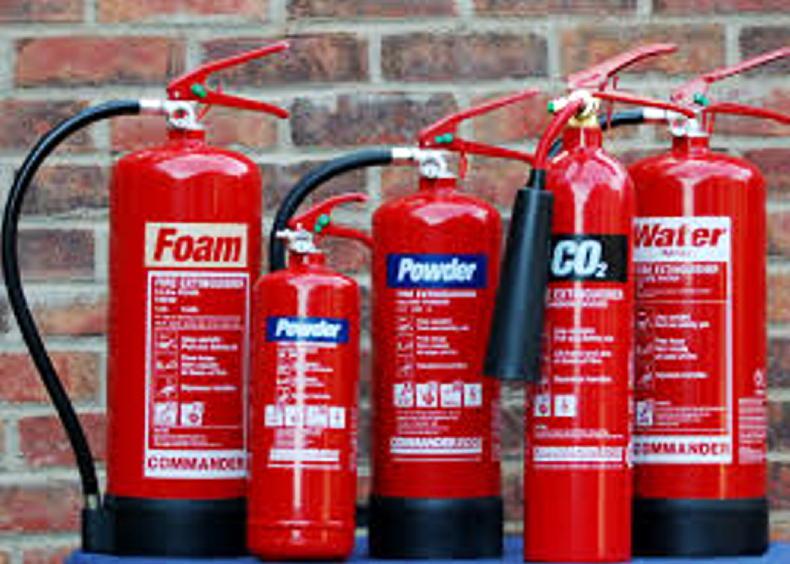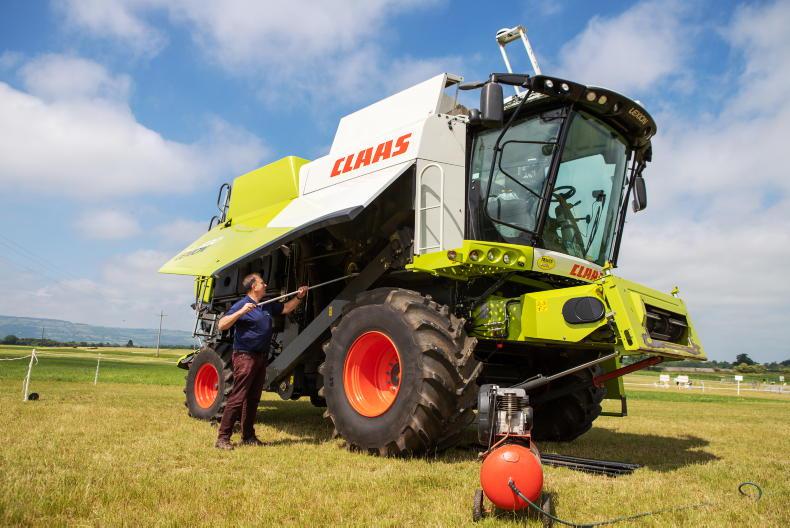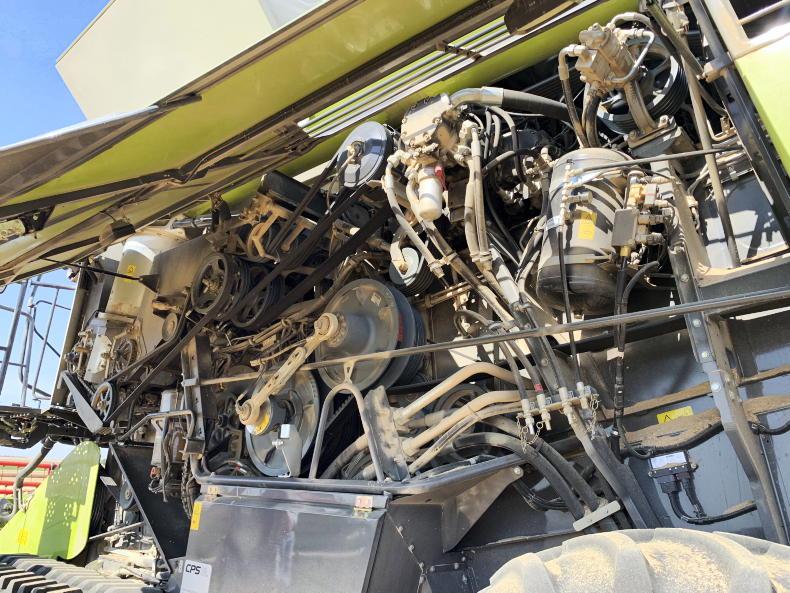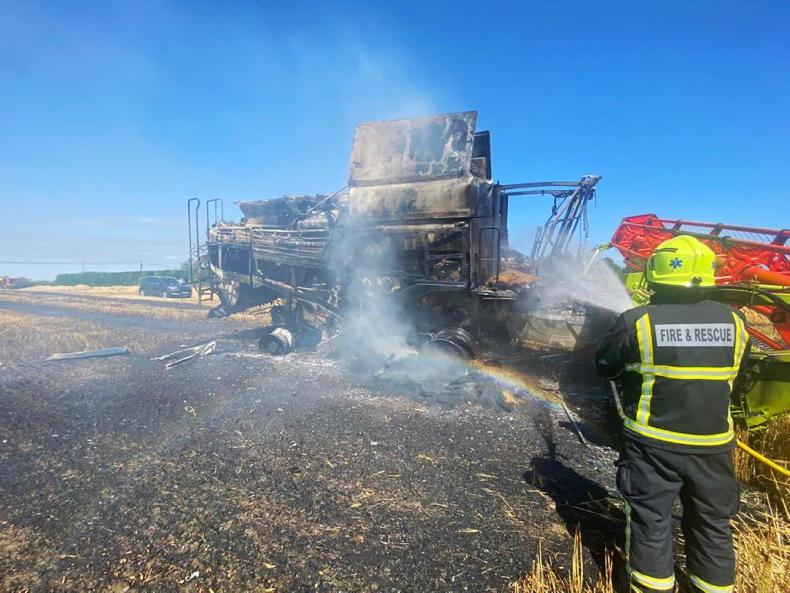With the warm and dry monthwe have had, crops are looking good and harvest is quickly now nearly in full swing.
As temperatures soar as high as 30°C this week in some parts of the country, working conditions remain tough for both man and machine if they are to perform to their optimum levels.
With the warm dusty conditions its essential operators go that extra step in ensuring machines are running cool to prevent overheating and the dreaded risk of fire.

All machines should be fitted with a fire extinguisher.
Harvest is only under way a number of days and there has already been a number of unfortunate operators see machines go up in flames before their eyes as result of overheating and component failure.
To reduce your chances of a similar disaster happening there are a number of steps one can take, some of which we outline below.
Although the majority of these tips relate to combine harvesters, they can be adopted for other machinery such as balers and forage harvesters.
Although not a pleasant job at the end of a long day, it is essential that machinery is blown down.
Do so wearing a mask (ideally full face) and boiler suit, while using an air compressor. It is recommended that this is done at the end of every day or twice daily if necessary.

The combine should be blown down thoroughly using an air compressor every evening.
Ensure the keys are out of the ignition before you start.
If this is not done in the evenings there is still a possibility machines can catch fire even though they are not running
Doing this in the evening time provides piece of mind that the combine is at less of fire overnight and for the simple fact you don’t have to sit in a warm cab itching from the dust all day.
It is essential any build up of grains, chaff and dust is removed from around bearings and other moving parts throughout the combine.

Given the degree of components on any combine naturally means there is plenty of areas dust and chaff can build up.
If this is not done in the evenings there is still a possibility machines can catch fire even though they are not running. Once parked, the engine is not running therefore it is not cooling meaning heat slowly dissipates through the machine without airflow or the cooling effect of a machine in motion. This can cause dust and chaff to begin smouldering and lead to a fire.
Areas to focus on include:
Engine bay and cooling pack: Blow the engine bay down thoroughly focusing particularly on areas such as the turbo and exhaust manifold. Blow out the air filter also and the end of the day and radiator too if it appears to be blocking with dust. That said, most radiators on modern machines have rotary screens to prevent this. Hydraulics: Components such as hydrostatic pumps and motors can act as a shelf for chaff and dust, blow these areas down along with hydraulic pipes. Carefully check the condition of oil pipes too as a burst pipe in the current warm working conditions could quickly lead to fire.Axles and drivelines: Blow down all drivelines where dust or chaff might be present. As well as this blow down around the axles and in around wheel hubs where dust might build up over the course of the day. Bearings: Ensure all bearings and housings are free from dust and chaff as grease tends to attract dust. Most fires often start from a bearing failing, heating up and causing fire.Electrics: Pay particular attention to all electrical components such as wiring looms and batteries. Blow all dust and debris away.It is important not to forget about other machinery in the fleet such as tractors and loaders during the current hot spell.
Tractors on trailer duties will gather a lot of dust and chaff in around the engine and back end from side filling and driving up dusty roads and fields.
Blow out the tractors cooling pack, engine and back end every evening too to help improve cooling and reduce the risk of fire. Depending on the application and machine temperatures, radiators may have to be cleaned out twice or three times daily.

This shows the devastating consequences when things go wrong. It is important combines are constantly monitored and that all precautions are taken to ensure a trouble free harvest. \Tom Lawlor.
Daily maintenance and checks
Every morning when the machine is cool and there is good daylight, carry out daily routine maintenance.
This is the best time to refuel. Refuelling at night will literally only be adding fuel to the fire in the unlikely and unlucky event a machine is to catch fire overnight. Grease bearings and other lubrication points. While doing this look for potential signs of early bearing or belt failure. If a belt can be twisted 360° by hand then it needs to be tensioned.Check engine oil level, hydraulic oil level and coolant level etc.Empty stone traps.Check header and replace broken crop lifters or knife sections.Inspect wobble boxes and lubricate the header if necessary. Throughout the day closely monitor machine temperatures ie engine temperature, transmission etc. Act immediately if these temperatures start to rise. Carry fire extinguishers on all machines as precaution.Switch off isolators or dead man switches on machinery at night.If possible, park a tractor and water bowser/tanker and pump in the field being harvested as precaution and quick response if the worst happens.For those who want to take all precautions, have a tractor and cultivator parked on the headland. This way a quick response can be made in the event a fire break needs to be created around a burning machine. This will help stop or slow down the fire from spreading and taking with it a field of crop. Read more
Field blaze destroys hundreds of straw bales in Kilkenny
Brand new harvester and 30ac of winter barley destroyed in blaze
With the warm and dry monthwe have had, crops are looking good and harvest is quickly now nearly in full swing.
As temperatures soar as high as 30°C this week in some parts of the country, working conditions remain tough for both man and machine if they are to perform to their optimum levels.
With the warm dusty conditions its essential operators go that extra step in ensuring machines are running cool to prevent overheating and the dreaded risk of fire.

All machines should be fitted with a fire extinguisher.
Harvest is only under way a number of days and there has already been a number of unfortunate operators see machines go up in flames before their eyes as result of overheating and component failure.
To reduce your chances of a similar disaster happening there are a number of steps one can take, some of which we outline below.
Although the majority of these tips relate to combine harvesters, they can be adopted for other machinery such as balers and forage harvesters.
Although not a pleasant job at the end of a long day, it is essential that machinery is blown down.
Do so wearing a mask (ideally full face) and boiler suit, while using an air compressor. It is recommended that this is done at the end of every day or twice daily if necessary.

The combine should be blown down thoroughly using an air compressor every evening.
Ensure the keys are out of the ignition before you start.
If this is not done in the evenings there is still a possibility machines can catch fire even though they are not running
Doing this in the evening time provides piece of mind that the combine is at less of fire overnight and for the simple fact you don’t have to sit in a warm cab itching from the dust all day.
It is essential any build up of grains, chaff and dust is removed from around bearings and other moving parts throughout the combine.

Given the degree of components on any combine naturally means there is plenty of areas dust and chaff can build up.
If this is not done in the evenings there is still a possibility machines can catch fire even though they are not running. Once parked, the engine is not running therefore it is not cooling meaning heat slowly dissipates through the machine without airflow or the cooling effect of a machine in motion. This can cause dust and chaff to begin smouldering and lead to a fire.
Areas to focus on include:
Engine bay and cooling pack: Blow the engine bay down thoroughly focusing particularly on areas such as the turbo and exhaust manifold. Blow out the air filter also and the end of the day and radiator too if it appears to be blocking with dust. That said, most radiators on modern machines have rotary screens to prevent this. Hydraulics: Components such as hydrostatic pumps and motors can act as a shelf for chaff and dust, blow these areas down along with hydraulic pipes. Carefully check the condition of oil pipes too as a burst pipe in the current warm working conditions could quickly lead to fire.Axles and drivelines: Blow down all drivelines where dust or chaff might be present. As well as this blow down around the axles and in around wheel hubs where dust might build up over the course of the day. Bearings: Ensure all bearings and housings are free from dust and chaff as grease tends to attract dust. Most fires often start from a bearing failing, heating up and causing fire.Electrics: Pay particular attention to all electrical components such as wiring looms and batteries. Blow all dust and debris away.It is important not to forget about other machinery in the fleet such as tractors and loaders during the current hot spell.
Tractors on trailer duties will gather a lot of dust and chaff in around the engine and back end from side filling and driving up dusty roads and fields.
Blow out the tractors cooling pack, engine and back end every evening too to help improve cooling and reduce the risk of fire. Depending on the application and machine temperatures, radiators may have to be cleaned out twice or three times daily.

This shows the devastating consequences when things go wrong. It is important combines are constantly monitored and that all precautions are taken to ensure a trouble free harvest. \Tom Lawlor.
Daily maintenance and checks
Every morning when the machine is cool and there is good daylight, carry out daily routine maintenance.
This is the best time to refuel. Refuelling at night will literally only be adding fuel to the fire in the unlikely and unlucky event a machine is to catch fire overnight. Grease bearings and other lubrication points. While doing this look for potential signs of early bearing or belt failure. If a belt can be twisted 360° by hand then it needs to be tensioned.Check engine oil level, hydraulic oil level and coolant level etc.Empty stone traps.Check header and replace broken crop lifters or knife sections.Inspect wobble boxes and lubricate the header if necessary. Throughout the day closely monitor machine temperatures ie engine temperature, transmission etc. Act immediately if these temperatures start to rise. Carry fire extinguishers on all machines as precaution.Switch off isolators or dead man switches on machinery at night.If possible, park a tractor and water bowser/tanker and pump in the field being harvested as precaution and quick response if the worst happens.For those who want to take all precautions, have a tractor and cultivator parked on the headland. This way a quick response can be made in the event a fire break needs to be created around a burning machine. This will help stop or slow down the fire from spreading and taking with it a field of crop. Read more
Field blaze destroys hundreds of straw bales in Kilkenny
Brand new harvester and 30ac of winter barley destroyed in blaze










 This is a subscriber-only article
This is a subscriber-only article










SHARING OPTIONS: